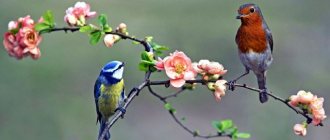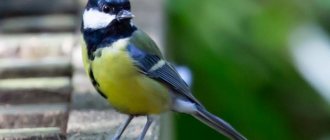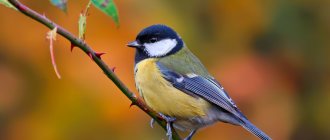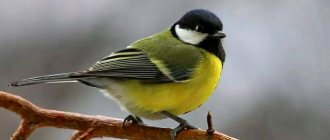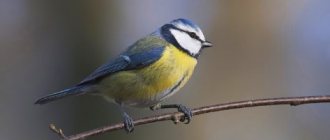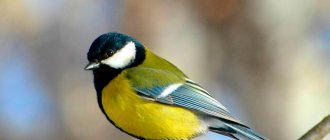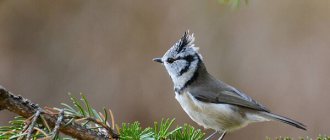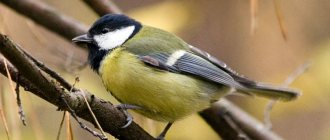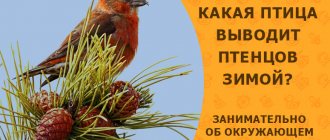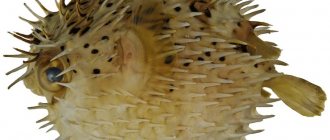general characteristics
Tits, members of the order Passeriformes, are usually distinguished by their large size and long tail. Their chest area is quite light compared to other plumage, usually yellow, beige or gray. The beak is short and sharp, the head has a cap and a crest.
The size of tits varies from 13 to 17 cm with a weight of 15 to 22 g. This determines the small wingspan, which is about 24 cm. The bird's head and neck area is black, there is an olive tint in the upper part, and a yellow color in the lower part. At the same time, there is a black stripe in the abdominal area. The cheeks are usually white, which stands out especially against the black background. The color of the plumage depends on the variety.
Long-tailed Tit or Chickadee
This small bird is so named because of its long tail, along with which the shape of its body resembles a cutlery. The color of the head, neck and belly is white, the back and wings are black with pink and brown streaks, and the tail and sides are pale pink. Listed in the Red Book of Moscow under the third category of rarity.
Where do tits live in the wild?
Tits are considered very common birds, found in different parts of the world. The habitat of birds is extremely wide:
- Africa.
- Asia.
- Europe.
- America.
A significant part of the bird population lives in Asia. More than a dozen species of tits can be found in Russia and Ukraine.
Tits do not live in South and Central America, Antarctica, Australia, or the Caribbean.
These birds choose open areas to live. They build their nests in clearings and forest edges, regardless of the type of forest. However, mixed, deciduous forests become the preferred habitat for life. The habitat depends on the specific species. For example, birds living in Europe prefer oak forests to live, and Siberian tits live next to people on the outskirts of the taiga.
At the same time, dark forests are not suitable for tits to build nests. Birds love forest-steppe areas, where there are natural bodies of water nearby: rivers and lakes. In addition, tits are sometimes found in the mountains, for example in the Alps.
Elena
Ask a Question
Question to the expert
How long do tits live on average?
Tits are good at adapting to environmental conditions, regardless of whether they live in captivity or in freedom. In natural conditions, the life expectancy of birds is only three years - this is the maximum they can count on. Such a short period is due to the dangers, diseases and lack of food that await the birds in their natural habitat. But at home, the life expectancy of tits increases to 10-15 years.
What does a tit eat in the wild?
Tits belong to the group of insectivores and, despite their small size, effectively deal with a large number of pests. Birds are engaged in cleaning vegetable gardens, parks, orchards, and forests, while their diet directly depends on the season.
In winter, due to the lack of insects, tits have to eat mainly plant foods.
When tits are unable to obtain food on their own, the birds try to get closer to people. In winter, they are often fed with white bread, sunflower seeds and even raw lard. In the absence of feeders, birds have to look for food in trash and landfills.
Tit eats rowan
In the warm season, the diet of tits expands significantly and is supplemented with familiar elements:
- Dragonflies.
- Bedbugs.
- May beetles.
- Ants.
- Flies.
- Wasps.
- Leaf beetles.
Plant foods are also present, but as a supplement. Tits feed mainly on pine needles, berries, lilacs, burdocks, rowan berries, blueberries, and rosehip seeds.
Some species of tits can hunt larger prey. For example, birds are capable of catching and eating small bats, especially when they are most vulnerable after a period of hibernation.
A notable feature of tits is their ability to hunt invertebrate insects living in the bark of trees. Tits hang upside down, clinging to branches, which helps them quickly get to a hiding target. Not only adult individuals, but also larvae of small invertebrates become prey. During the day of such a hunt, a tit can eat more than six hundred insects. Sometimes the mass of such prey is equal to the bird’s own weight.
Tits are often called forest orderlies, as they hunt many harmful insects: cockroaches, ticks, centipedes, etc. They can even eat bees, provided the sting is removed. Tits feed their offspring mainly on butterfly caterpillars no larger than 1 cm in size.
Great tits differ from their relatives because they do not store food for the winter. Most tits, for example, blue tits and black tits, store food in advance so as not to remain hungry in conditions of food shortage.
Diet of forest orderlies
During breeding, birds feed on invertebrates and their larvae. Nurses with wings rid trees of many pests. But the basis of the diet are the following delicacies:
- spiders;
- midges and flies;
- weevils;
- mosquitoes;
- bedbugs;
- butterfly caterpillars.
The menu is not complete without cockroaches, grasshoppers, crickets, dragonflies, centipedes, ants and lacewings. An adult can also eat a bee, from which it first removes the sting.
With the arrival of spring, the prey of forest orderlies are dwarf pipistrelle bats, which are sedentary after hibernation.
The young are usually fed on butterflies and caterpillars up to 1 cm long.
With the arrival of cold weather, birds switch to food of plant origin: wheat, oats, corn, rye, hazel seeds. The singing orderlies do not neglect the feeding troughs in the parks, where they feed on crumbs of bread and pieces of lard.
The character and habits of the tit
The character of tits is quite active and mobile, but at the same time the birds themselves are non-aggressive. They do not conflict with each other and rarely come into conflict with other birds or animals. Tits are calm towards people and can even eat food from their hands. Birds become aggressive only during the nesting period and when raising offspring. At this time, they actively seek to defend their territory from competitors and potential enemies, and then they often attack and drive other birds away from their nest.
Birds are distinguished by their peaceful nature, which helps them get along calmly with both other birds and people. Tits show great attentiveness and caution, due to which they are less likely to be caught by cats and other predators, unlike quarrelsome sparrows.
Interaction with people
Recommended by topic
Blackbirds Woodpecker Heron
People and tits get along well together: the birds prefer to move closer to human buildings in times of famine. In winter, tits are highly dependent on the help of people who organize feeders and feed birds left without food. It is best to add sunflower seeds to the feeders, which tits love more than other plant foods. These birds can be called real gourmets: they choose the largest seeds and take them for themselves, and leave the small, tasteless food for other birds.
In addition, tits in urban environments may not build their nests in open areas, but use various abandoned buildings for this.
Despite the fact that birds are extremely careful, with enough patience a person can feed them by hand. However, this is only available to those whom the tits know. Therefore, in order to gain their trust, it is necessary to feed the birds for a certain time. This way they will understand that the person is not dangerous and is beneficial to them. Tits, accustomed to one feeding place, are able to reward not only their communication, but also the destruction of insects in the territory, which is especially useful in the summer.
Question to the expert
Why do tits knock on the window with their beaks?
Tits are birds that have adapted well to living conditions near humans. They feel confident in an urban environment and have a good understanding of human habits. So, once upon a time, during the cold season, people hung out food in string bags attached directly to the windows. This was due to the small size of the refrigerator, which forced them to find ways to keep food cold. Brave and curious tits actively pounced on prey hung in this way, tearing wrappers and polyethylene. Such situations have formed the habit of tits to rush into the place of their feeders in a similar way. If the feeder is located next to the windowsill, and they are currently empty, the tits, without a twinge of conscience, can perform their usual actions and knock on the glass with their beaks. This is how birds demand food from their owners or try to get to a place where food should be contained.
Features of birds
It is difficult for the beautiful prankster to stay in one place for a long time; she loves movement. As for its habitat, the bird is completely unpretentious. In addition, birds have no equal in mobility, dexterity and curiosity. Thanks to its strong and tenacious legs, the little creature is capable of performing various somersaults and tricks.
Reproduction and raising of offspring
Numerous populations of tits are monogamous birds that form strong, stable partnerships. The male and female choose each other not just for one season, but for the rest of their lives and do all things together: from building a nest to raising offspring.
The breeding season begins in late winter before nest construction. Males who do not have a partner choose a place for future construction, and then invite a female using calling songs. When the partners have chosen each other, the construction process itself begins. The male is responsible for obtaining material, the female is responsible for arranging the home. After all work is completed, conception occurs. The female is capable of laying from 5 to 15 eggs, which take about two weeks to hatch.
The eggs are white, with spots and red-brown dots on their shells. Tits can lay eggs at least twice a year. The first brood appears at the end of April, the second in July.
While the female is incubating the offspring, the male provides her with food. When the chicks appear, the female spends the first few days warming them and carefully monitoring the condition of the newborns. This is due to the fact that the chicks are born almost completely naked, and therefore suffer from cold weather, wind, etc. At this time, the male’s task becomes feeding not only the female, but also the newborn offspring, which increases the degree of load.
How are highways different?
One of the subspecies of true tits is the great tit; unlike the common tit, they do not choose a place to live for a long time. They prefer simpler and easier options. They can live in pipes, rocks, abandoned houses. Sometimes abandoned birdhouses are occupied. They also like to nest in trees, where they make hollows.
Great tits have a black head and neck and white cheeks. The top is olive and the belly is yellow.
The great tit is the largest in size, growing up to 17 centimeters and weighing from 14 to 22 grams. Imagine, the wingspan of great tits can reach 26 centimeters .
They lay from 6 to 11 eggs. The female incubates them for about two weeks. This species is aggressive. They are almost not afraid of people. They have their own way of life. For example, when they feed, weaker relatives are driven away from food.
Bolshaks produce at least 40 sounds that are different in tone, timbre, tempo and pitch. Males sing more. When the mating season comes, there is no trace left of the fast and joyful birds. They become violent towards each other and may even fight.
Natural enemies of tits
Tits are considered very active and fast birds. What they lack in endurance they make up for with speed and natural caution. This helps them to encounter dangerous predators among animals and birds less often, and also to practically avoid being caught by people. Catching a tit is quite difficult, but despite this, the birds become desirable prey for many predators. Thus, among the natural enemies of tits we can distinguish:
- Owls.
- Kites.
- Eagles.
- Barn owls.
In addition, the enemies of birds include woodpeckers, which are capable of destroying and ruining nests built by tits.
Birds also often suffer from property damage caused by the interference of squirrels, ants, and other birds. In the natural environment, tits themselves die due to fleas, the colonies of which are often found in nests. For the same reason, barely hatched chicks die.
Predators such as weasels and ferrets are capable of hunting fragile individuals. Insufficiently experienced and resourceful tits can become victims of these agile predators. In addition, they often attack at the moment when the birds are most vulnerable: while building a nest or while eating.
Despite the fact that tits have quite a lot of natural enemies, this is not the main cause of bird mortality.
A large percentage of mortality is due to hunger associated with lack of food. A significant part of tits die in winter due to the inability to feed on insects and obtain plants. The frost itself is not as terrible for birds as hunger.
Habitats
The Moscow tit is found in almost all corners of the Earth. Most of all, such tits are attracted to African forests and forests of Eastern and Western Europe. People who want to see Muscovite should visit the spruce forests. These birds feel most comfortable in them. However, tits can also live in mountainous areas with forested slopes.
Additional Information. Muscovites almost never nest at an altitude of more than two thousand meters, and therefore they will not be seen on mountain tops.
The main feature of black tits is their constant mobility. They rarely sit still and are almost always looking for new places to live. Despite this, in regions with a milder and warmer climate, birds try to live more sedentary. If the temperature is constantly above zero, they will not have to fly south for the winter. In colder regions, tits experience seasonal migration. For the winter they move to public gardens or coniferous forests.
Muscovy nests are made on tree branches or in hollows. In rare cases, they live in the burrows of field mice. However, due to the abundance of enemies, tits prefer to settle higher off the ground.
